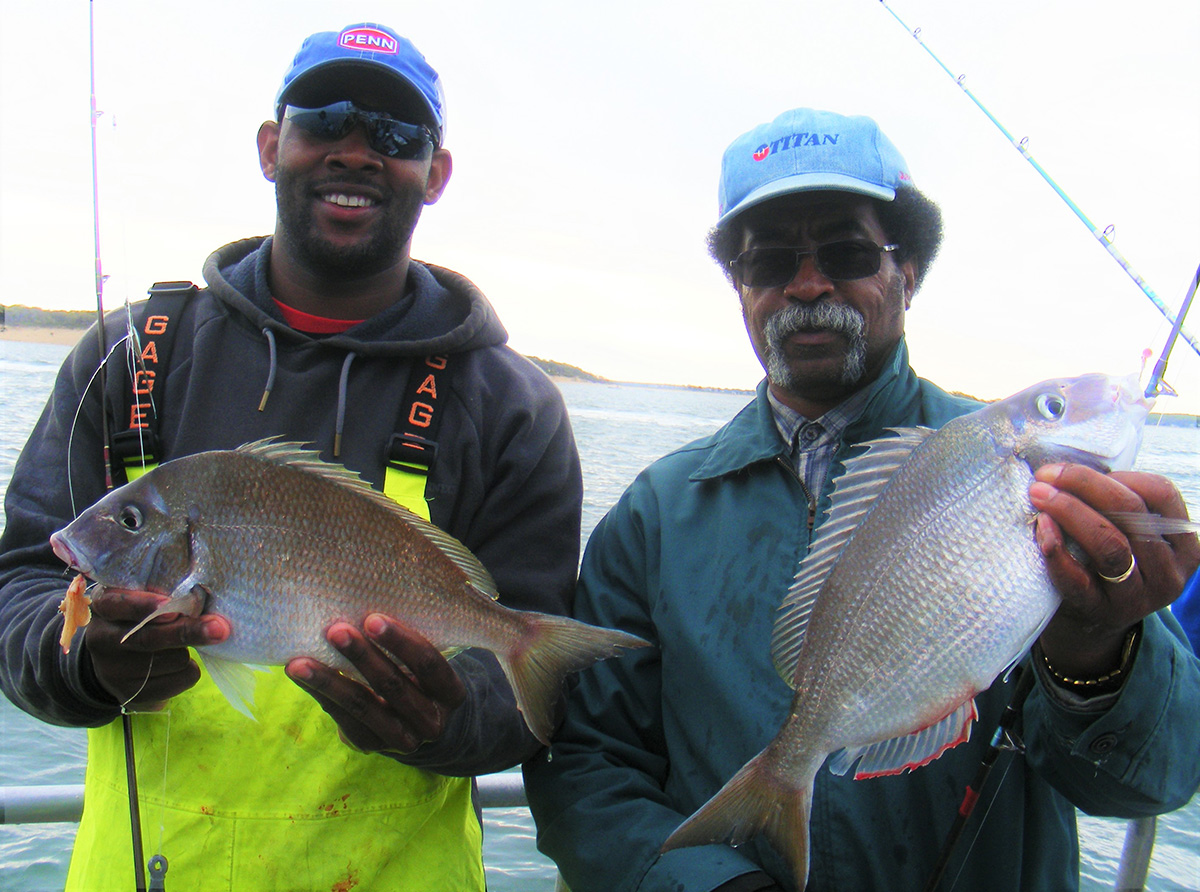
It’s been happening well before you and I were born. In fact, it’s probably been happening since the beginning of time. I’m talking about the arrival of giant sea porgies and weakfish that reside inside the Peconic Bay Estuary from May through June.
Both species enter the estuary having two missions to complete: spawn and eat and understandably so. Both Great and Little Peconic Bays are structure rich bodies of water where there are countless tidal rips, tidal clashes, deep holes, rock piles and drop-offs that invite myriad bivalves, squid, spearing, bay anchovies and bunker, to name a few during the spring migration making for the ideal stopover for the widely sought species.
Early and Late Arrivals
By late April/early May weakfish travel through the Shinnecock Canal and congregate around areas such as Robins Island, Jessup Neck and Noyack Bay in order to spawn off their eggs. In the meantime, large sea porgies look to bump heads with the seatrout situated along the same area with the intentions of dropping their eggs and feasting out as well. Shallow water and the ideal habitat of the Peconic Estuary are key factors to why weakfish and porgies continue to return here year after year to lay their eggs. Since water temperature and salinity are controlling factors of the survival and viability of the two species’ eggs, one can only estimate when the actual spawning will take place. Once the spawning cycle is complete (which is usually by the end of June) the majority of the large fish vacate the area and head for the deeper cool waters of the Sound and ocean where they spend the summer and early fall season. Shortly after the departure of the spring run fish, the younger smaller siblings of the porgies and weakfish fill the void and situate in similar habitats as their parents during the summer months.
Hot Spots of June
The past two seasons has seen Noyack Bay as one of the hottest weakfish spots, while Jessup Neck and southward of the western end of Shelter Island is where the jumbo scup reside. Last season saw incredible catches of weakfish from late May and ran into August. And by the looks of things, this spring and summer should be a repeat of last. Anglers have reported fish to 8 pounds and catch as many as 30 a person per tide. The area of buoy 16 has been where the seatrout have settled. South Fork sharpie Ken Morse of Tight Lines Inc. in Sag Harbor suggests during the incoming tide start out by the 16 buoy in 12 feet of water, and the drift will take you south to 54 feet of water, which are the magic numbers for the best results. Aside from weakfish near buoy 16, you have a bit of everything according to Ken, with jumbo porgies chewing down squid and clam strips during June. Bluefish and even some big stripers are frequent visitors at the same time as the big scup. During the summer and into autumn, kingfish, blowfish, summer weakfish, snapper blues, bay porgies and even some quality sea bass are all in the kettle for those anchoring and clam chumming anywhere along the drop-off. The current is moderate here at peak speed with 3-ounce sinkers and 1-ounce jigheads usually sufficing. If you find for some reason the buoy 16 area is not producing, wait until the current begins to ease and head over to buoy 17 by Jessup Neck and try fishing the 70-foot depths on both sides of the buoy. You’ll find more of the mixed bag here as well; however, the current pushes much harder. Add in the deep water and it’s going to be a lot harder to hold or bounce the bottom. Therefore don’t waste your time until the last or the first hour of either tide. Be advised that the sea robins can drive you nuts should you land on a nest of them by buoy 17. Then again, there are also some mighty big sea bass there as well.
More Silver and Gold Hot Spots From June On
The waters off Nassau Point are an excellent area in June that often produce good size weakfish and jumbo scup. Depths fluctuate enormously off Nassau Point as the average water depth surrounding the point is between 25 and 35 feet. However, approximately three quarters of a nautical mile ENE of red buoy 22 lies a deep pocket of water between 60 and 70 feet. It is this deep water that has often been overlooked yet excellent weak fishing can be found here on any moving tide during the day. Generally, however, the start of the outgoing definitely has the edge. Working this area thoroughly certainly increases your chances of filling your limit.
Just opposite of Nassau Point, Rose Grove gives way to excellent scup and weakfish action that really lights up from June through September. Along the west side of Shelter Island, the area known as the Green Lawns has always been a popular fluke haunt throughout the spring, however plenty of jumbo porgies and very respectable weakfish also reside with fluke here through June. Also, don’t ignore the southern tip of Robins Island (South Race) close to the bell buoy 25 and the nun buoy at 26, which are chock full of scup and spurts of weakfish. This area should be drifted coming on or off the drop-off south of the island where it will drop or rise (depending on how you drift) from approximately 18 feet to 30 feet of water. The current can really rip through here, so fish this area as the current eases and especially on a tide change. Lastly there is the area that surrounds Roger’s Rock, which is chock-full of rocks and strewn bottom—tailor-made for scup. Since this is a relatively large area, you can run into a school of porgies at any given time. If you’re looking for a starting point, try just east and north of the obstruction buoy or along the edges of where the rocks meet the sandy bottom in 20 to 25 feet of water along the north side of the rock. Anyone heading to Rogers Rock for porgies should anchor on the backside (east side) of the rock in the 10- to 15-foot depths and make sure to have a couple of chum pots filled with frozen blocks of clam chum in order to draw the scup to the boat for some fast pace action. Keep in mind that although both sides of the tide with moving water produces, shallow water porgy fishing is often torrid just after dawn or just before dusk. You may want to plan accordingly; however, plenty of daytime action is available at Rogers. While clams and squid often work just fine on the scup, having some sandworms on hand can be a day saver, since porgies rarely pass up the red meat, especially when the barometric pressure is high.
Drift, Anchor, Mark the Spot
Drifting is best when it’s slow to moderate. Both weakfish and porgies respond well with drifting. Fast drifts may be better benefited by anchoring, especially in the deep depths. Should that be the case, then a couple of chum pots filled with frozen clam chum is paramount to get and keep fish to the boat. Regardless of where you may wet a line, don’t leave home without a navigation chart, especially if you are trailering and visiting the area. Yes GPS does a great job of keeping tabs of where you are, but the charts can be studied and potential spots can be pin pointed and put in the GPS for future reference.
Light and Lively
On the tackle front, conventional or baitcaster outfits in the 15- to 20-pound class filled with a good quality braid or mono line suffice. As for rigs, standard hi/lo and porgy rigs are properly suited for the Peconic pork chops. Clams, worms and squid are the chef’s recommendation to fill a cooler with scup. If you are set on employing bait for the weakfish, pendent shape squid strips applied to a high/low rig certainly catch the attention of the weakfish. Sinkers from 2- to 4-ounces round out the terminal end.
On the flip side, Fin-S-Fish, Bass Assassins and Berkley Gulp! fished on 1/2- to 2-ounce leadheads are just a few choices that put a beating on the weakfish, and when the stripers are around, they slam them as well. While the top choices are a few goodies, the relatively new Squid Tails by Spro Corporation stand above the rest as they produce phenomenal results. Designed to mimic squid, the lifelike action of the soft plastic squid tail really did the job on the weakfish jigged right along the bottom. Best of all, we fished them without any help of enticers on the hook. The Spro Squid Tails come in several different weights (1/2 to 3 ounces) and several colors. We found the 1/2 and 3/4 ounce white, glow and pink equally effective. The Squid Tails also feature a custom designed Gamakatsu 3x strong hook for sharpness, strength, and durability. The Squid Tail’s unique shape of the head and placement of the eyelet make these center balanced jigs unique in the way they bounce along the bottom. Add in the bulging eyes, holographic finish and blazing colors, and you have the perfect elements to keep the rods bending with weakfish. These jigs don’t fall or hang straight down as is the case with most jigs. Its gliding motion through the water acts as if it is swimming along. When jigged along the bottom, its body stays almost parallel giving the jig a very natural appearance. While the Squid Tails may be perfectly suited for jigging weakfish, don’t be fooled as they also do a superb job of duping fluke and sea bass as well. For some sure fire action, try the bounties of the Peconic Bays. Please remember there is a one fish limit at 16 inches or better with weakfish, therefore please practice self-restraint and obey the law. As for the porgies, also please practice self-restraint, limiting the cooler to what you are going to use. By doing your part, you won’t earn much silver but it will certainly earn you gold.



